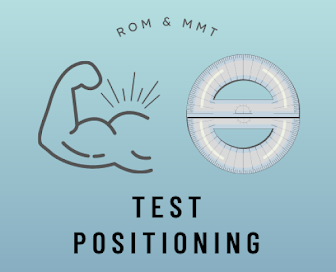Test Position with ROM and MMT
What exactly is "test positioning"? Test positioning is what helps us position ourselves in the best way possible to correctly test our muscles manually. The two basic assessment testing are Manual Muscle Testing and Range of Motion. The purpose of Manual Muscle Testing (MMT) is what helps determine weak muscles and help collect data on whether or not the treatment is actually working with strengthening that specific muscle. Another basic testing assessment that is used is called Range of Motion (ROM), which tells us the amount of motion that is available within a joint. ROM is typically measured in degrees with a goniometer, which is a tool that is used to help measure joint motions.
When using these testing assessments, you want to be accurate with how you execute the test. With ROM, it is important to use bony landmarks and proper positioning when measuring a client's joint angle with a goniometer to ensure the accuracy of the measurement. The client should always be in the same position each time of measurement with both ROM and MMT testing to also ensure the accuracy of the measurement. Within treatment, the use of assessing ROM and measuring with a goniometer helps with setting goals to meet the normal range and helps show progress. To be precise with measuring, you must be at eye level with the axis of the goniometer. The axis is the midpoint of the body of the goniometer and should be aligned with the bony landmark. The stationary, or nonmoving, arm of the goniometer should be aligned with the stable end of the joint whereas the moving arm should be aligned with the joint that is moving and being measured. Once the goniometer positioning is correct, you must also check and see if the client is in the correct position. This also helps with accuracy as you do not want the client to be using other muscles to help perform the action of the joint that is being measured. For example with elbow flexion, you do not want the client to use other muscles to help with this action as you are only measuring flexion of the elbow. If it is difficult to locate important landmarks in order to place a goniometer, you can palpate the specific landmarks to ensure accuracy as well.
With performing MMT, you want to assess the muscle weakness as well as check to see if the treatment has been helping and showing progress as muscles become stronger. This test is similar to ROM, but what makes it different is how the specific movement relates to the forces of gravity and how the muscles respond to manual resistance. When assessing MMT, you want to make sure the client is not in complete ROM to what they are fully capable of, but make sure they are in the midpoint of that. This is also known as mid-ROM. This position is ideal for this test assessment because it is where the optimal formation of the muscle cross-bridges are. You want to make sure the client is in this correct position because you do not want them to use compensatory muscles that substitute this action and that will help them resist the force that is being applied. Going back to our example of elbow flexion, the normal range for that is 0-145 degrees. You want your client to be positioned correctly and have their elbow at about half of 145 degrees, which would be around 70 degrees. From there you will want to apply resistance to the distal end of the bone and use your other hand to palpate the correct muscles that are going against the resistance.
As we are taught as future OT practitioners to care for everyone's well-being, we would not position a client in a testing position that could be more harmful to them and cause more pain than normal. Many clients will be too weak to participate in these tests and that is where we would have to put them in a position that eliminates gravity. You would want the client to be in a comfortable position and have the muscle that is being tested placed in a way that is parallel to the ground. With elbow flexion, you could have the client sitting with their arm on a table or have them laying on their non-injured side. Gravity-eliminated positions still help with getting accurate results while also being safe and considerate of the clients that might not be able to produce the muscle movement in a normal, against gravity, position.




Comments
Post a Comment